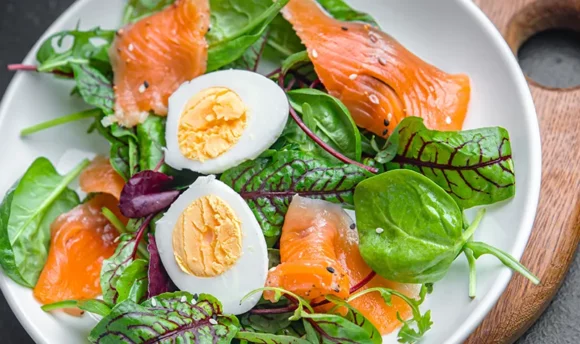Keto vs. Atkins – What Is the Distinction Between the Two?
Both of these diets are extremely popular. Let’s take a closer look at them.

Low-carb diets are becoming increasingly popular for weight loss, weight maintenance, and healthy living in general.
While some people choose to stick to calorie-restricted diets, others are open to any diet that will help them reach their goal weight.
Two of the most popular low-carb diets are keto and Atkins. Choosing between the two might be daunting, so we have put together a list of features that will help you narrow down your options.
Keto Diet: What Is It?
The ketogenic diet is a low-carb diet that advocates for high-fat, moderate-protein, and low-carb intake. The diet has become one of the most preferred dietary plans for losing weight and managing diabetes in recent years.
Fat contributes for 70–80% of the daily calorie intake on the ketogenic diet, with protein accounting for 20–25% and carbs accounting for 5–10%.
A keto diet typically results in rapid weight loss due to the carb restriction intake to fewer than 50 grams per day. The body begins to break down fat, and when the glucose reserves deplete, ketone bodies appear, serving as a backup energy source.
Essentially, fat replaces sugar from carbohydrates as the primary energy source in the body. As the body burns fat, it enters ketosis, which aids in weight loss.
Following a low-carb diet might be challenging. However, various apps are available to assist people in keeping track of their macronutrients.
What Can You Eat and Avoid on a Keto Diet?
The ketogenic diet allows for the consumption of healthful unsaturated fats and saturated fats found in oils, lard, butter, and cocoa butter.
While protein is a component of the diet, keto does not often distinguish between lean protein and protein sources that are heavy in saturated fat like beef, pork, and bacon.
All fruits are high in carbohydrates. However, you can eat specific fruits, primarily berries, in small amounts.
You should limit non-starchy leafy greens, whole grains, beans, lentils, peas, peanuts, and low-fat dairy products. Keto also discourages sugary beverages, added sugars and sweeteners, and conventional snacks.
Is Keto Really Healthy?
Many people acknowledge a low-carb diet as safe and nutritious, but the question of whether keto falls into this category is still open to debate.
The diet helps you lose weight in the short term because of its low-carb intake and place a heavy emphasis on fats, with modest amounts of protein and relatively few carbohydrates.
Pregnant or lactating women should avoid the fat-burning state of ketosis because of their greater glucose requirements. Those on dialysis or with high creatinine levels should stay away from the keto diet.
The keto diet’s moderate-to-high protein intake may be hazardous to those with compromised renal function because the kidneys process much of the protein we consume. Type 1 diabetes patients should avoid this diet since it increases their risk of hypoglycemia and diabetic ketoacidosis.
Pros and Cons of the Keto Diet
Following the low carb-restricted keto diet may provide you with specific health benefits. However, the diet can have adverse effects as well.
Pros
- While they maintain ketosis, many people experience decreased appetite and weight loss.
- Some studies show that low-carb diets help manage blood sugar levels for type 2 diabetes and boost insulin sensitivity.
- A significant benefit of the diet is that it eliminates practically all processed foods and refined carbohydrates, detrimental to good health.
- Over time, the ketogenic diet proves to be useful in the management of epilepsy. Recent studies also show that children and adults alike on the ketogenic diet experience a reduction in seizure frequency.
- The ketogenic diet decreases the demand for complex mitochondrial processes since it provides an alternative metabolic pathway thus decreasing the incidence of Parkinson’s disease.
- Neuroprotective effects of the ketogenic diet enhance social behavior, cognitive abilities, and long-term memory.
- Chronic pain management may improve from the anti-inflammatory effects of ketogenic diets.
- Patients with chronic renal disease may benefit from a low-protein ketogenic diet. Chronic renal disease sufferers can benefit from its ability to correct metabolic imbalances.
- Chronic pain may decrease from a ketogenic diet’s ability to reduce inflammation.
- Cell-specific oxidative stress from the keto diet also enhances the potency of chemotherapy and radiotherapy. It also aids in the preservation of lean body mass in cancer patients by conserving protein.
Cons
- Nutritional deficiency and constipation are possible side effects of cutting down whole grains, legumes, and many vegetables.
- Fatigue, headaches, cognitive fog, and an unsettled stomach, known as keto flu, are among the most common short-term side effects of ketosis.
- Several people find it challenging to maintain.
The Atkins Diet: What Is It?
The Atkins diet aims to alter the metabolic rate by using very high fat intake as energy instead of carbohydrates. Furthermore, you do not have to keep track of how many grams of net calories you are consuming, but you have to monitor your carbohydrate intake.
Limiting carbs on the Atkins diet, particularly in the beginning stages, is highly advisable. As a result, it uses a metric known as net carbohydrates, which measures total carbs minus fiber content.
This diet has four phases.
- You consume 20 grams of net carbs per day in Phase 1, the most restrictive part of the process, which speeds up weight loss.
- Phase 2, which does not yield the same rapid weight loss that Phase 1 does, allows an intake of 30 net carbs.
- A weekly increase of up to 10 grams in net carbs is what you should aim for in Phase 3. The diet plan advocates continuing this phase until you reach your desired weight.
- In Phase 4, the maintenance phase, there are no restrictions on calories or macronutrients. You can consume as much as 120 net carbs a day and still stay within your goal weight range.
Other Atkins diets allow for 40 or 100 net carbs from the start, depending on the plan. Those who have minimal weight to shed or hope to maintain their current weight might consider these options.
What Can You Eat and Avoid on the Atkins Diet?
Atkins focuses on the consumption of leafy greens and non-starchy veggies, butter, cheeses, full-fat yogurt, olive oil, and other foods with healthy fats. It also allows fatty proteins from beef, pork, poultry, seafood, fatty fish, nuts, and seeds.
Atkins discourages whole grains, sugar and sweetened foods, and alcohol, especially in phase 1. From phase 2, the diet allows you to take low glycemic fruits such as berries and melon, legumes, starchy veggies, and dairy products. It also allows you to take low glycemic fruits moderation from phase 2, legumes, and whole grains but in moderation.
Is Atkins Safe?
The Atkins diet is a trendy eating plan in the US, but one dogged by questions about its safety. Weight loss and a reduction in cholesterol levels are some of the main benefits of this diet.
Despite this, some doctors are reluctant to suggest Atkins-style diets because the high-fat content could lead to an elevated risk of heart and kidney disease.
Others argue that the diet is safe as long as one follows it under the supervision of a dietitian or recommendation of a physician.
Pros and Cons of the Atkins Diet
Even with the increased popularity of the Atkins diet, going low-carb is not ideal for everyone. Here are the pros and cons of following the diet.
Pros
- Aids in losing weight and maintaining it.
- It does not require you to keep track of the calories you take daily.
- It advocates for filling low-fat unprocessed foods.
- It helps to lower blood sugar.
Cons
- In Phase 1, the diet limits the consumption of fruits, dairy, and whole grains that contain many nutrients the body needs.
- Lack of essential nutrients and high fat content might lead to health issues.
- It offers a limited selection of foods.
- It is not an entirely easy diet plan to maintain.
- One of the requirements of the diet is to keep track of net carbs.
- Following the Atkins diet is expensive. You will need to buy protein bars, bread, and more.
Difference Between Keto and Atkins Diets
As compared to Atkins, the keto diet uses a moderate-protein regimen. A typical keto diet allows for 70–80% of calorie intake from fat, 20–25% from protein, and 5–10% from carbohydrates.
The goal of the keto diet is to help the body maintain ketosis for as long as possible.
When you start eating more carbs on the Atkins diet, your body will lose its ability to stay in ketosis. The Atkins diet advocates the consumption of a broader range of healthy foods, which includes more fruits and vegetables and some grains.
As a whole, Atkins is a less restrictive method because it does not need you to watch ketones or adhere to specific macronutrient objectives to remain in ketosis. Atkins allows for more carbs than keto, as the latter tends to eliminate all but 5% of carbs and does not let you eat much fruit.
Keto is higher in fats, while Atkins emphasizes proteins as a significant macro to focus on.
Atkins has different levels based on how many carbs you are looking to consume per day, while with keto, you have to go all in.
Keto and Atkins Similarities
Fat, protein, and carbohydrate macronutrient ranges are the same in both Atkins and keto diets.
There are many similarities between keto and Atkins regarding the foods allowed on the diet plans. The two restrictive diets advocate for seafood and fatty fish, lean meat, low-carb vegetables, eggs, healthy fats, nuts, and dairy products.
Both keto and Atkins diets severely restrict high-carb foods, sugar, starchy veggies, and processed foods.
Both Atkins and keto aid in weight loss and help manage the blood sugar level in people with type 2 diabetes.
Keto vs. Atkins: Which One Is Better?
Keto may offer a slight advantage in weight loss based on current research. It can improve cognitive performance, regulate and occasionally reverse diabetes, and potentially stop or relieve cancer symptoms. More research shows that long-term ketosis is safe.
Due to its lack of clinical use, Atkins has not generated nearly as many studies as the more popular keto diet. However, unlike the keto diet, Atkins is more sustainable.
A Word From Nutritionist
It is challenging to choose between the two diets – keto vs. Atkins. However, when you consider the benefits derived from the two low-carb diets, keto is more effective than Atkins when talking about weight loss. It also helps reduce other illnesses or health conditions such as epilepsy, Parkinson’s disease, diabetes, and chronic pain, among others.
On the other hand, Atkins allows for more carbs, enabling you to dine out frequently for a comprehensive selection of menu items and nutritious foods.
In the end, it all comes down to whether or not you are willing to stick to a low-carb diet and the flexibility of your metabolism. Alternating between keto and Atkins is an excellent way to see which works best for you.
Conclusion
Both keto and Atkins are essentially low-carb diets and good for weight loss and type 2 diabetes management. However, the keto diet is a more popular diet for a reason.
The Atkins diet contains more fat than the average diet, but keto is a very effective tool when it comes to weight loss. Both diets have their advantages and disadvantages, and the one you choose between the two will depend on your dietary and nutritional requirements.
Always consult with your doctor before starting any diet.

















































 Select your language:
Select your language: 








